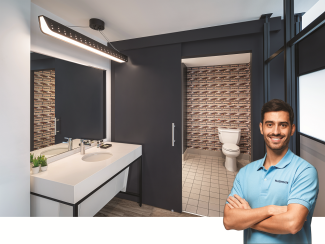
Clogged toilets are bad for business.
For facility managers, restroom upkeep is an essential responsibility, particularly in the hospitality industry, where clean and functional restrooms are a must. Consider this: a bustling restaurant may allocate 60-90 minutes each day to cleaning their restrooms in addition to time spent on regular maintenance and repairs.
Hotels and apartment complexes also invest substantial resources in restroom maintenance, as prompt resolution of restroom issues is paramount for guest and resident satisfaction. However, this maintenance comes at a cost, which can be reduced by the type of toilets you install.
A pressure-assisted toilet can help reduce the resources you devote to restroom maintenance by reducing (or eliminating) clogs, helping keep the bowl cleaner, saving water and making repairs easier and less frequent.
And when you spend less time and money on restroom maintenance—without reducing the cleanliness or operational capabilities of your restrooms—you have more time and money to devote to more productive parts of your business. Here’s how.
Pressure-assisted Flushing Nearly Eliminates Clogged Toilets
Fixing a clogged toilet isn’t just a time-consuming maintenance problem—it’s a problem that usually comes at the worst possible time. Like the middle of the dinner rush. Or the middle of the night.
And with conventional gravity toilets, clogs are a problem that occurs far too often. Say a gravity toilet clogs about one–two times per year. If you have six toilets, that means you’re dealing with a clog every other month. If you manage an apartment complex with 300 units, you could deal with one–two clogs per day.
Unlike gravity toilets, a pressure-assisted toilet—also known as a power-flush toilet—contains a sealed vessel within the tank that compresses trapped air and uses the water supply line pressure to compress the trapped air. When a flush is triggered, this compressed air expands and forces the water into the bowl, so instead of “pulling” waste out with a siphon action, the pressure-assisted unit “pushes” waste out with significantly greater force.
This powerful flushing action is why pressure-assisted toilets are far less likely to clog—even using as little as one gallon of water per flush.
The manager of an apartment complex who installed 400 toilets with Flushmate pressure-assist units says, “In almost eight months, we have had only five toilet-related maintenance calls. We used to get that many on a Saturday. We got our skilled maintenance men out of the toilet business and into the skilled labor business for which they were intended.”
Pressure-assisted Toilets Need Less Cleaning to Look Clean
Hospitality businesses can’t have teams cleaning toilets during peak hours, because the restrooms are occupied by guests. But guests will judge businesses harshly if they see messy-looking toilets.
That’s another maintenance benefit of pressure-assisted toilets—they stay cleaner-looking longer, so they need less cleaning to look clean.
Pressure-assisted toilets keep toilets looking clean in two ways:
- First, pressure-assisted toilets tend to have a larger water surface than traditional gravity toilets, covering more surface area so there’s less area for nasty stuff to cling to. Combined with the powerful flushing action, that keeps toilet bowls looking cleaner.
- Second, because all the water in a pressure-assisted toilet tank is contained within an inner vessel, you won’t see the “sweating” on the exterior of the tank that you often see on a gravity toilet.
Cleaner toilets mean your visitors will be less likely to get a negative impression from their restroom visits—and your staff won’t have to spend as much time cleaning them.
Pressure-assisted Toilets Are More Durable
Aside from clog removal and routine cleaning, toilet repairs are another time-consuming restroom maintenance job—and another way pressure-assisted toilets reduce maintenance.
Pressure-assisted toilets have fewer moving parts than many gravity toilets, and most of the serviceable parts are easy to replace. So, they’re not only extremely durable, they’re easy to fix on the rare occasions when they do need repairs.
Over time, your savings from having to perform fewer repairs can be significant. Add those savings to the time your staff doesn’t have to spend cleaning toilet bowls or removing clogs, and you can see what an advantage it can be to replace gravity toilets with pressure-assisted toilets.
Are pressure-assisted toilets right for your next apartment complex, hotel, restaurant, or public facility? Talk to the experts at Flushmate!